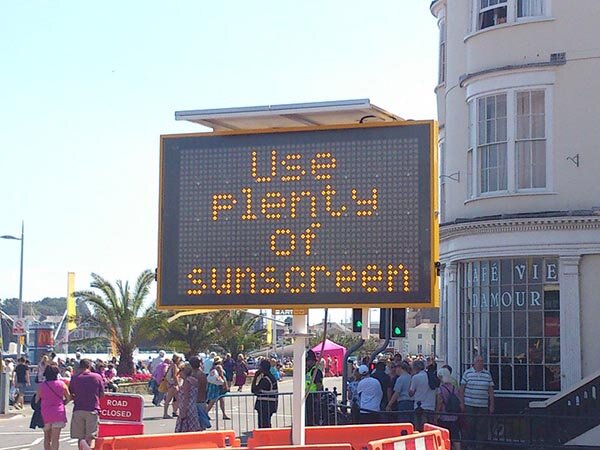What Happens If You Drink Sunscreen?
Just because it protects you from the sun doesn’t mean it can’t damage your body in other ways.
By Jessie Schiewe
There’s an episode from “It’s Always Sunny in Philadelphia” where the group drinks tequila out of empty sunscreen bottles on the Jersey Shore to bypass the beach’s no alcohol rule.
Charlie, however, gets mixed up and chugs from a bottle filled with actual sunscreen. Fully-dressed and wearing sneakers, he wades into the ocean, knocking back sips from the bottle which he believes to be full of booze.
Later, his friends point out that he’s been drinking sunscreen the whole time — but Charlie couldn’t care less.
“It’s good,” he says, tilting his head back so that he can squirt a stream of the lotion down his throat. “It gets you all unghghgh.”
Remarkably, despite the fact that he’s been ingesting loads of toxic chemicals, Charlie doesn’t end up in the emergency room later in the episode (although Dee does, for an unrelated reason).
He does however vomit, which is one of the more common reactions that occur from drinking sunscreen. Unlike his friends who stealthily and successfully imbibed tequila, Charlie doesn’t become intoxicated either.
But getting drunk from drinking sunscreen is actually possible. Why? Because one of the main ingredients often found in it is alcohol.
Children are the most at risk for getting drunk from drinking sunscreen because their body masses tend to be lower than an adult’s and they’re also unaccustomed to having alcohol in their systems.
It’s likely that the writers for “It’s Always Sunny in Philadelphia” decided not to make Charlie get a buzz from the sun cream simply because it would be too unrealistic. His weight and the fact that he is no stranger to booze would have likely made him intolerant to the sunscreen’s tiny percentage of alcohol.
While it’s not a good idea to drink sunscreen, you can always drink out of a flask that looks like a bottle of the stuff. (Amazon)
Though various types of alcohol exist, the ones found in sunscreen tend to be the more harmful, volatile kind, known as ethanol, denatured alcohol, isopropyl alcohol, methanol, or benzyl alcohol. They’re the same ones you’d find in a handle of vodka or a six-pack of beer, which is why many prisons and rehab facilities consider sunscreen to be contraband. Spray-on sunscreens in particular tend to have the highest alcohol contents.
But including alcohol in the formulas for sunscreen does serve a purpose. The organic compounds create a quick-drying finish so that when the product is applied, it feels lighter and less oily on the skin. It can enhance the absorption of other ingredients as well, which can be beneficial if the sunscreen contains sun-damage protectants such as Vitamin C. Alcohol also acts as a preservative, extending the product’s shelf life so that it can be used from one summer to the next.
As global warming worsens, you might find yourself having to apply more and more sunscreen. (Flickr/Maggie)
Skin cancer affects more than 3 million people a year in the United States. In 2020 alone, melanoma, the most deadly type, will kill an estimated 6,850 people. It’s one of the most commonplace cancers you can get, and it’s caused by repeated and unprotected exposure to ultraviolet rays, be it from the sun or a tanning bed.
Sunscreen, as the name implies, is a key tool in preventing the development of such cancers. Even early civilizations used sunscreens, concocting them from plant-based ingredients with naturally protective qualities. Ancient Greeks applied olive oil to their skin, which contains antioxidants and sun-blocking proteins, while ancient Egyptians relied on extracts of rice, jasmine, and lupine flowers for similar effects. Plant-based sunscreens have also been used amongst certain populations in the Philippines, Malaysia, and Indonesia, often in the form of pastes containing mixtures of weeds, bark, rice, and spices.
Modern sunscreens, made with synthetic ingredients, were introduced to the market in 1936 by the French chemist Eugène Schueller, who later founded the brand L’Oreal.
The next one came out in 1944, invented for the U.S. military by an American pharmacist named Benjamin Green. The goal was to prevent overexposure to the sun for soldiers fighting in the Pacific tropics during World War II. Green used a mixture of cocoa butter and red veterinary petrolatum to create the UV radiation-blocking substance, which was red in color, as well as sticky and viscous. He formed the brand Coppertone a few years later.
By the late 1970s, water-resistant sunscreens had become commercially available, with further advancements arriving in the 1990s, namely the introduction of gels and sprays.
The sunscreen market has flourished even more since then. People are even trying to make drinkable SPFs a thing. And, in the coming decades, as our ozone layer becomes even more threadbare and depleted, sunscreen will likely see even greater advancements, as well as an uptick in users.
A lot of people slather on sunscreen without questioning the ingredients it contains. (Flickr/Alex Liivet)
But though science has provided us with an effective tool for blocking out the sun’s harmful rays, skepticism about the safety of the ingredients used in them also exists.
Research has shown that sunscreen doesn’t just sit atop our skin and act like a shield. Our bodies actually absorb it, with the chemicals used in the products entering our bloodstream. Those amounts also multiply quickly when you consider that sunscreen is not a seldom used resource but something that is often worn daily, if not applied multiple times in one day.
When it comes to worrisome ingredients, alcohol is on that list — and not just because it can make you inebriated. High doses of it can lead to dehydration, low blood pressure, shock, coma, and even death, although research has yet to directly link these symptoms to sunscreen usage. Still, the risks are there just as there is when ingesting high amounts of any toxic chemical in the body.
Research has found that other commonly used sunscreen ingredients have the potential to cause cancer, birth defects, allergic reactions, and internal bleeding.
The struggle is real when using zinc- or titanium-based sunscreens. (Flickr/Indexorama)
Of course, there are alternatives out there. Sunscreens that rely on naturally occurring, inorganic compounds, such as zinc oxide and titanium dioxide, are widely regarded as safer and equally effective options. These types of ingredients do not absorb into the body but remain on the surface of the skin, serving as a barrier against the sun.
Their only caveat is that, because they aren’t absorbed, they’re visually noticeable, often leaving skin greasy and chalky white. And when you consider most sunscreens on the market today, that’s generally the antithesis of what brands are aiming for with their products. Hence why people so often turn to alcohol-based SPFs to protect them from the sun.
Yes, they contain toxic chemicals, but the trade-off is they don’t make you look like a ghost. And therein lies the rub of modern sunscreen — literally.
















